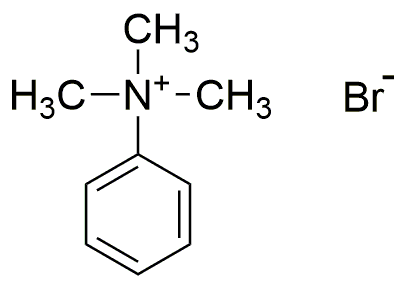Trimethylphenylammonium bromide is widely utilized in research focused on:
- Phase Transfer Catalysis: This compound acts as an effective phase transfer catalyst, facilitating reactions between organic and aqueous phases, which is particularly useful in organic synthesis.
- Ion Exchange Processes: It is employed in ion exchange applications, helping to remove unwanted ions from solutions, making it valuable in water treatment and purification processes.
- Biological Research: In biological studies, it serves as a quaternary ammonium compound, aiding in the study of membrane interactions and cellular processes.
- Electrochemistry: The compound is used in electrochemical applications, enhancing the conductivity of solutions and improving the efficiency of electrochemical cells.
- Surfactant Applications: As a surfactant, it helps in stabilizing emulsions and foams, making it useful in the formulation of various consumer products, including cosmetics and detergents.
General Information
Properties
Safety and Regulations
Applications
Trimethylphenylammonium bromide is widely utilized in research focused on:
- Phase Transfer Catalysis: This compound acts as an effective phase transfer catalyst, facilitating reactions between organic and aqueous phases, which is particularly useful in organic synthesis.
- Ion Exchange Processes: It is employed in ion exchange applications, helping to remove unwanted ions from solutions, making it valuable in water treatment and purification processes.
- Biological Research: In biological studies, it serves as a quaternary ammonium compound, aiding in the study of membrane interactions and cellular processes.
- Electrochemistry: The compound is used in electrochemical applications, enhancing the conductivity of solutions and improving the efficiency of electrochemical cells.
- Surfactant Applications: As a surfactant, it helps in stabilizing emulsions and foams, making it useful in the formulation of various consumer products, including cosmetics and detergents.
Documents
Safety Data Sheets (SDS)
The SDS provides comprehensive safety information on handling, storage, and disposal of the product.
Product Specification (PS)
The PS provides a comprehensive breakdown of the product’s properties, including chemical composition, physical state, purity, and storage requirements. It also details acceptable quality ranges and the product's intended applications.
Certificates of Analysis (COA)
Search for Certificates of Analysis (COA) by entering the products Lot Number. Lot and Batch Numbers can be found on a product’s label following the words ‘Lot’ or ‘Batch’.
Numéro de catalogue
Numéro de lot/série
Certificates Of Origin (COO)
This COO confirms the country where the product was manufactured, and also details the materials and components used in it and whether it is derived from natural, synthetic, or other specific sources. This certificate may be required for customs, trade, and regulatory compliance.
Numéro de catalogue
Numéro de lot/série
Safety Data Sheets (SDS)
The SDS provides comprehensive safety information on handling, storage, and disposal of the product.
DownloadProduct Specification (PS)
The PS provides a comprehensive breakdown of the product’s properties, including chemical composition, physical state, purity, and storage requirements. It also details acceptable quality ranges and the product's intended applications.
DownloadCertificates of Analysis (COA)
Search for Certificates of Analysis (COA) by entering the products Lot Number. Lot and Batch Numbers can be found on a product’s label following the words ‘Lot’ or ‘Batch’.
Numéro de catalogue
Numéro de lot/série
Certificates Of Origin (COO)
This COO confirms the country where the product was manufactured, and also details the materials and components used in it and whether it is derived from natural, synthetic, or other specific sources. This certificate may be required for customs, trade, and regulatory compliance.


